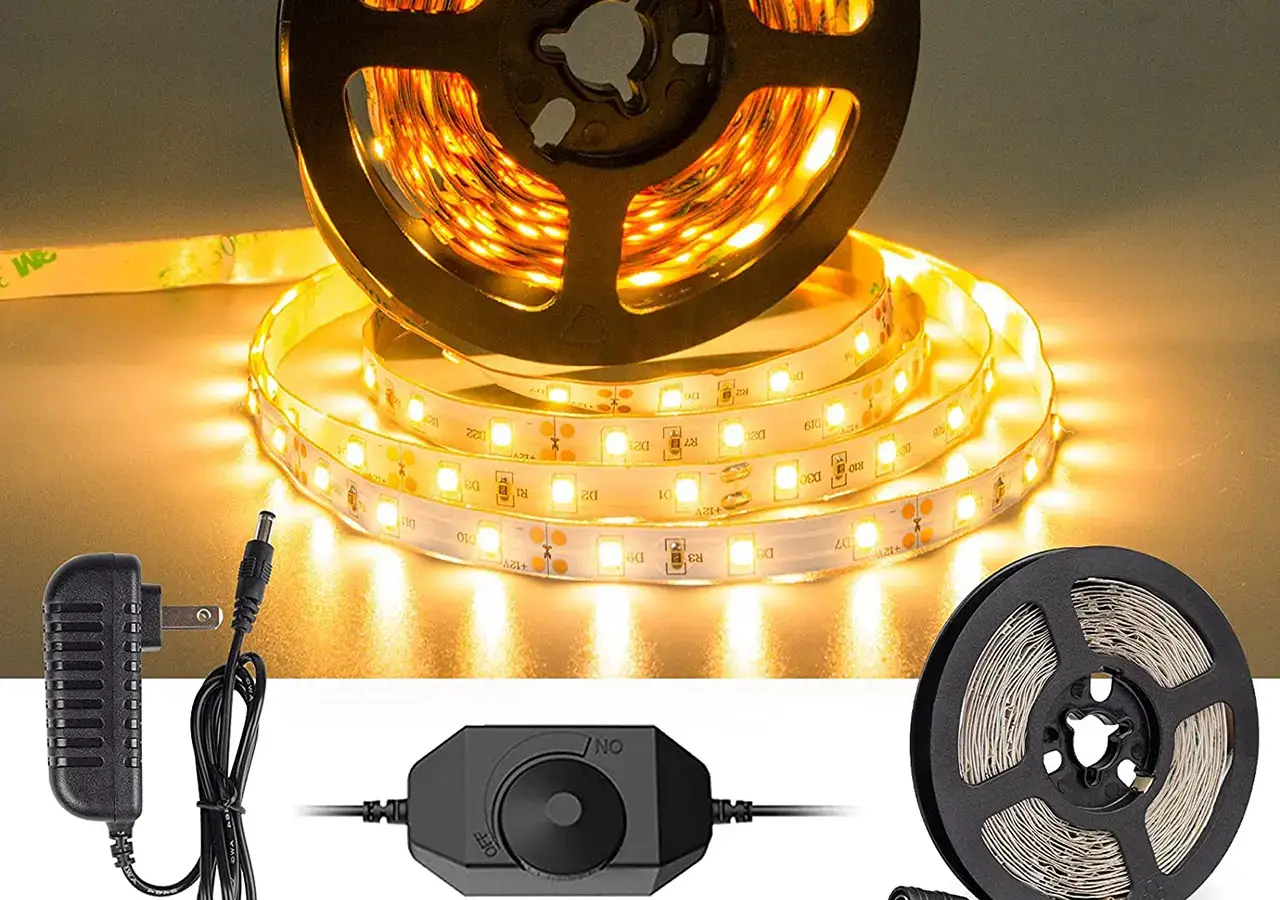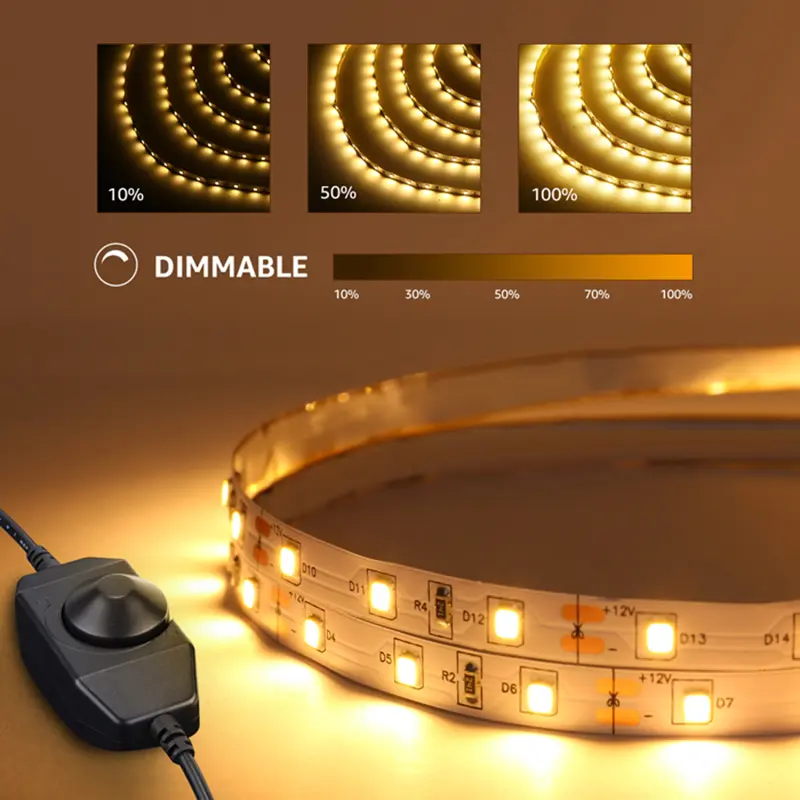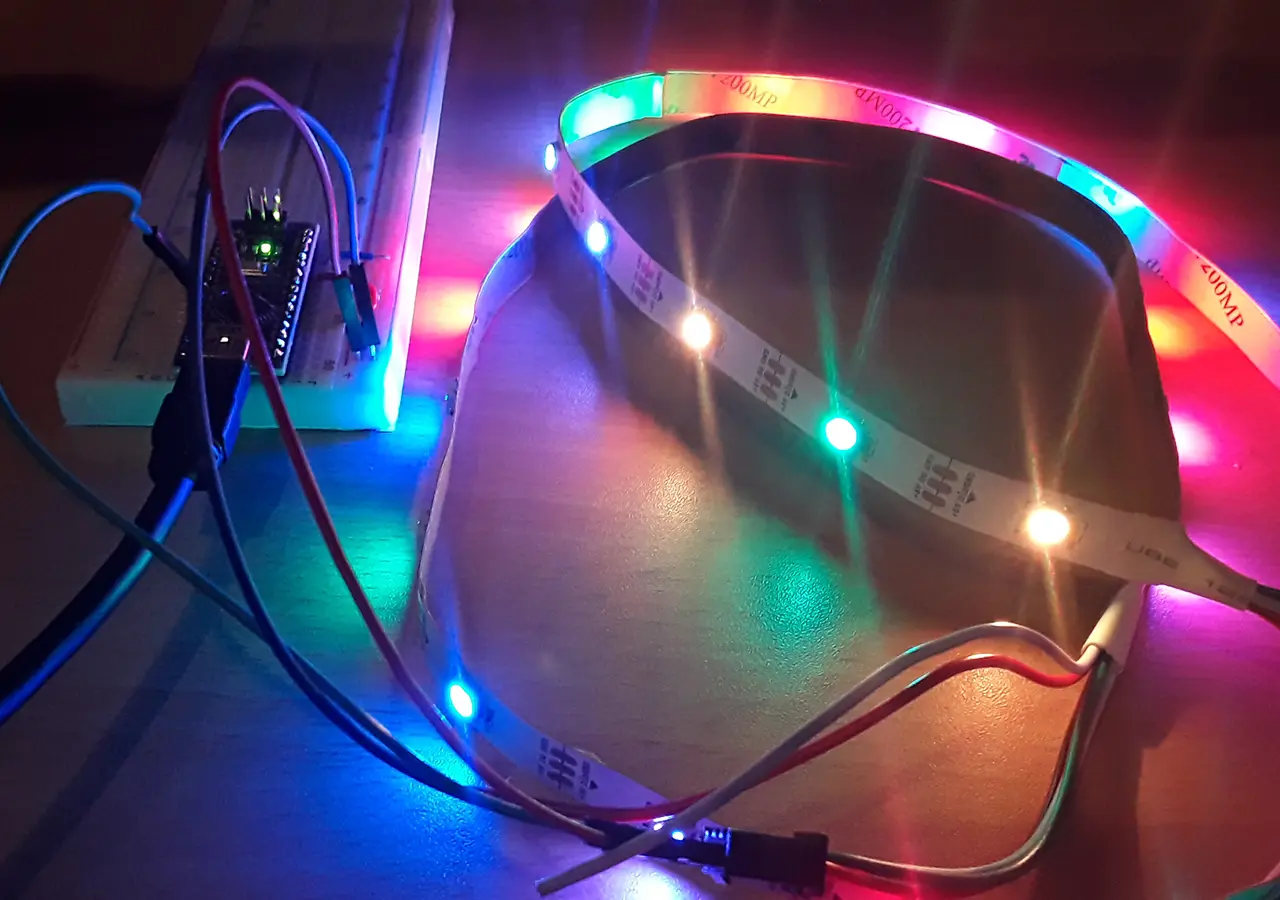Ever wondered how to tame the dazzling brilliance of your LED strip lights? Dimming them is the answer. By adjusting the brightness of your LED strips, you can create atmospheric lighting effects that suit any mood or occasion.
I am Tom, have been engrossed in the LED industry since 2005. Hope my vast experience and passion for the topic ensure that the information provided here is accurate, comprehensive, and easy to understand.
In the following sections, you will journey through the inner workings of LED strip lights, exploring factors influencing their dimming capabilities, understanding the necessary tools, and following a step-by-step guide to accomplishing the task. Additionally, you’ll discover expert tips for perfect dimming and extending the lifespan of your LEDs.
There’s a lot to cover, but don’t worry – I will guide you through each step of the process. So, let’s dive right in and illuminate the path to mastering the art of dimming your LED strip lights!
The Importance of Proper LED Strip Light Brightness
Brightness is a crucial aspect of any lighting system. It influences the comfort of those within it. Too bright, and you may be dazzled or distracted; too dim, and you may struggle to perform necessary tasks. LED strip lights offer a practical solution, allowing users to control the illumination intensity according to their needs.
Dimming Capabilities of LED Strip Lights
LED strip lights have risen in popularity due to their ability to provide tailored lighting solutions. They are renowned for their dimming capabilities, permitting a broad spectrum of brightness levels. From a soft, calming glow to full, energetic brightness, LED strips offer unparalleled lighting options.
Unveiling the Brightness Levels of LED Strips
LED strip lights are known for their ability to provide different brightness levels, typically measured in lumens. The higher the lumens, the brighter the light. However, it’s not just about raw brightness—dimming these lights can create the perfect atmosphere for any occasion.
Understanding the Technology Behind LED Strip Lights
LED technology has revolutionized the lighting industry, making it vital to understand how it works and how dimming is possible.
How LED Strip Lights Work
LEDs (Light Emitting Diodes) are semiconductors that emit light when current flows through them. Strip lights consist of multiple LEDs soldered onto a flexible circuit board. This design ensures evenly distributed light, making them ideal for various applications.
How Does LED Strip Dim
Dimming LED strips involves reducing the voltage or pulse width modulation. In simple terms, this means reducing the amount of light produced by each diode. By controlling the current flowing through the diodes, it’s possible to adjust the strip’s overall brightness level.
Factors Influencing the Dimming of LED Strip Lights
Several factors affect how effectively you can dim LED strip lights, from power supply considerations to the LED chip quality and the type of dimmer used.
Power Supply: Voltage, Amperage, and Dimming Method
The power supply plays a pivotal role in dimming. Voltage and amperage must be compatible with the strip lights’ requirements. Additionally, the power supply must support the chosen dimming method—whether low-voltage, phase-cut, or PWM (Pulse Width Modulation).
LED Chip Quality: CRI, CCT, and Dimming Compatibility
The quality of the LED chip is crucial. Its CRI (Color Rendering Index) affects how accurately it displays colors, while CCT (Correlated Color Temperature) impacts the warmth or coolness of the light. The chip must also be compatible with the dimming mechanism for smooth, flicker-free brightness control.
Dimming Control Systems: Types of Dimmers and Controllers
The type of dimmer and controller also plays a significant role. Some options include RF (Radio Frequency), 0-10v, Dali, or app-based systems. Each has its benefits, but compatibility with your LED strip is essential.
Tools and Materials Required to Dim LED Strip Lights
Before dimming your LED strip lights, ensure you have the right tools and materials.
Essential Tools: Wire Cutters, Strippers, and Voltage Tester
You’ll need wire cutters and strippers to adjust your LED strip’s length and prepare the ends for connection. A voltage tester is also beneficial to ensure a safe and adequate power supply to your LEDs.
Choosing a Dimmer and Controller: RF, 0-10v, Dali or App-based
The choice of dimmer and controller hinges on your specific needs and the lighting system you have in place. RF systems offer convenient wireless control, while 0-10v and Dali systems are often chosen for their precision and interoperability. For tech-savvy users, app-based controllers provide the convenience of adjusting light brightness from your smartphone.
Picking the Right LED Strip Light: Single-color, RGB or RGBW
The type of LED strip light you select also matters. Single-color strips are simple and straightforward, while RGB (Red, Green, Blue) or RGBW (RGB plus White) strips offer a wide variety of color options in addition to brightness control.
A Comprehensive Step-By-Step Guide to Dim LED Strip Lights
Now that you understand the theory behind LED strip light dimming, let’s explore the practical steps.
Step 1: Installing Your LED Strip Lights
Begin by measuring the area where you wish to install the lights. Once cut to size, use the adhesive backing to stick the strip in place, ensuring it’s secure and level.
Step 2: Connecting the LED Power Supply and Dimmer/Controller
Connect your LED strip to the power supply, ensuring correct polarity. Then, following the instructions, connect the power supply to your chosen dimmer or controller.
Step 3: Configuring and Calibrating Your Dimmer Settings
With everything connected, it’s time to configure and calibrate your dimmer. This process varies depending on the type of dimmer or controller you’ve chosen but generally involves setting minimum and maximum brightness levels.
Step 4: Troubleshooting Common Issues with Dimming LED Strips
If you encounter problems, like flickering or unresponsive lights, check your connections, ensure your power supply is adequate, and confirm your dimmer is compatible with your LED strip.
Pro Tips for Perfect Dimming and Maximizing LED Lifespan
A well-dimmed LED strip light can create an enchanting ambiance, but it’s also crucial to maximize the lifespan of your LEDs.
Safety Precautions When Dimming LED Strip Lights
Always ensure your power supply is switched off when installing or adjusting your strip lights. Don’t exceed the maximum load of your dimmer, and avoid touching the LED chips directly, as this can cause damage.
Optimizing LED Lifespan through Proper Dimming
Dimming your LED strip lights isn’t just about creating the right ambiance—it can also significantly extend the lifespan of the LEDs by reducing thermal stress.
Prolonging LED Lifespan with Correct Dimming Technique
Using your dimmer to maintain a moderate brightness level can prevent excessive heat build-up and power usage, thereby prolonging the longevity of your LED strip lights.
The Art and Impact of Dimming LED Strip Lights
There’s an undeniable art to using dimmed LED strip lights to enhance a space’s ambiance, energy efficiency, and versatility.
How Dimmed LED Strip Lights Enhance Ambience
Dimmed LED strip lights can create various moods within a room. Lower brightness fosters a relaxed, intimate environment, while a brighter setting promotes energy and alertness. It’s all about finding the balance that suits your location.
Utilizing Dimmed Lights for Different Settings
From creating a cozy atmosphere in living rooms to reducing eye strain in offices, dimmed LED strips are versatile. They’re perfect for movie nights at home, vibrant parties, or even as soft night lights.
Energy Efficiency: Saving Power by Reducing Brightness
Dimming your LED strip lights not only helps set the mood but also reduces energy consumption. By dimming to 50% brightness, you could save nearly the same percentage in power, supporting a greener and more sustainable lifestyle.
Exploring Different Dimming Methods for LED Strip Lights
Now, let’s delve into the various dimming methods available and how you can set them up.
TRIAC Dimming and Setup
TRIAC dimming is a popular choice for residential lighting due to its cost-effectiveness. It involves cutting off parts of the voltage waveform to reduce light output. The setup involves a TRIAC-compatible power supply and a TRIAC dimmer, which should be connected following the manufacturer’s instructions.
Low Voltage PWM Wall Dimmer and Setup
PWM (Pulse Width Modulation) dimmers control brightness by rapidly switching the LEDs on and off. They’re known for their efficiency and smooth dimming capabilities. To set up, connect a PWM dimmer between your power supply and LED strip, making sure to observe the correct polarity.
Additional Dimming Techniques
Other popular dimming techniques include 0-10v, where a separate low-voltage signal controls dimming, and DALI (Digital Addressable Lighting Interface), a protocol that offers precise and programmable dimming control.
Frequently Asked Questions about Dimming LED Strip Lights
You might still have some questions about dimming LED strip lights. Here are answers to some of the most common ones.
What factors influence the dimming capability of LED strip lights?
Several factors can influence the dimming capability of LED strip lights. These include the power supply’s voltage and amperage, the LED chip’s quality, and the dimming control system type. A good understanding of these components can help to achieve optimal dimming results.
Can all LED strip lights be dimmed? What to Know Before Buying?
Not all LED strip lights are designed with dimming capabilities. It’s crucial to check the product specifications before purchase to ensure they can be dimmed. Also, ensure the selected dimmer or controller is compatible with your specific strip lights.
Are there specific tools required to dim LED strip lights?
Yes, basic tools like wire cutters, strippers, and a voltage tester are often required. Additionally, a suitable dimmer and controller play a vital role in the dimming process.
Why is my LED strip light buzzing when dimming?
A buzzing sound during dimming can often be traced back to incompatibility between the LED strip light and the dimmer or controller. Make sure to use a dimmer and controller specifically designed for LED lights. If the problem persists, it’s best to consult with a professional.
What is the best way to extend the lifespan of my LED strip lights?
Proper dimming can significantly enhance the lifespan of LED strip lights. Always use compatible dimmers, controllers, and power supplies, and ensure the lighting is not consistently running at its maximum brightness.
How do dimmed LED strip lights enhance the ambiance of a room?
Dimmed LED strip lights can create a wide variety of atmospheres. From cozy and calming to vibrant and energetic, the power to transform the mood of your space is at your fingertips with dimmable LED strip lights.
How can I choose the right LED dimmer and controller?
The right choice depends on your lighting needs, existing setup, and personal preference. Research different types (RF, 0-10v, DALI, app-based), consider their pros and cons and check compatibility with your LED strip and power supply.
How does LED strip dimming contribute to energy efficiency?
Dimming LED strip lights can significantly reduce power consumption, contributing to energy efficiency. Remember, when you lower the brightness, you’re reducing energy usage!
Can I dim my LED strip lights using an app?
Yes, many modern LED strip lights offer smart control options, which include dimming via smartphone apps. These smart controllers provide convenient and flexible control over the brightness and color of your lighting.
Conclusion
Dimming LED strip lights is a blend of science and art, requiring a solid understanding of the technology and a keen eye for aesthetics.
Learning to dim LED strip lights allows you to create a customized ambiance while optimizing energy usage. It’s an essential skill for anyone interested in personalized, efficient lighting.
With this comprehensive guide, you are now equipped with the knowledge to embark on the rewarding journey of dimming your LED strip lights. It not only enhances the ambiance of your spaces but also optimizes the lifespan of your LEDs and conserves energy.
As you explore the dimmable LED strip lighting world, we invite you to share your experiences and discoveries. It’s through shared learning that we can fully harness the power and potential of this versatile lighting option.
In summary, dimming LED strip lights is about creating dynamic spaces that adjust to your moods, activities, and the time of day. With the p understanding, tools, and LED strips, you can start trooper discover the transformative power of lighting and how it can reshape your world. This isn’t just about lighting—it’s about improving the quality of life, making every moment matter. From a simple, practical perspective, it’s also about energy efficiency and maximizing the lifespan of your LED strips. Whether you’re a homeowner or a lighting enthusiast, we hope this guide will illuminate your path toward mastering dimming LED strip lights.
For top-tier LED strip lights, turn to Unitop. As a leading manufacturer in China since 2005, we specialize in LED strip lights with various dimmable solutions. Questions? Don’t hesitate – contact us! Light up your world with Unitop.
Related Articles
Leave a Reply
Want to join the discussion?Feel free to contribute!
Leave a Reply

Tom is now the Sales Manager of Unitop (China) Co., Limited. He has been in the LED Lighting industry ever since 2005. He is an expert in sales & marketing, and factory management. He likes bodybuilding, and he is also a crazy Apple Fan! He is a hard-working guy and loves to learn and try new things.
Email: tom@unitopledstrip.com WhatsApp: +86-18680307140






Welcome you all to share your opinions.